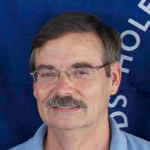|
Salinity's Connection to Climate Change and an Accelerated Water Cycle
What affects ocean salinity, and why should we care? The saltiness of the ocean is controlled by the water cycle. And the temperature and
salinity of ocean water together control ocean density - the crucial driver of ocean circulation. Dr. Schmitt explains how ocean
circulation works and its profound impacts on the climate.Webinar Archive
Concept Map: What Affects Ocean Salinity and Why Should We Care?
This concept map forms the basis of Dr. Schmitt's presentation.
Hover over the concepts to uncover additional resources, or save this map to your own CLIMB
account by clicking on the light blue wrench in the upper left corner and selecting "Copy Map to My Maps".
Applicable Next Generation Science Standards
SPURS Planning Blog [Blogspot] Chief Scientist Raymond Schmitt blogs from the R/V Endeavor during the second SPURS cruise Ocean Salinity Viewed from Sea and Space [NASA Earth Observatory]
NASA Program Scientist Eric Lindstrom describes why scientists want to spend six weeks at sea measuring ocean saltiness Are We There Yet? [NASA Earth Observatory]
It takes about a week from Woods Hole to reach our study site at 25N, 38W, giving us plenty of time to check and re-check instruments, provide training in various procedures, and get to know our work mates Profiling Salinity from the Ship [NASA Earth Observatory]
A workhorse of our voyage is the two primary means of measuring salinity from the ship: the Conductivity, Temperature, and Depth (CTD) instruments Seaglider #189 Away! [NASA Earth Observatory]
The Seagliders launched from R/V Knorr are meant to repeatedly survey a limited region of the ocean, measuring temperature, salinity, oxygen, chlorophyll fluorescence, and optical backscatter Starting A Career In Oceanography And The Global Water Cycle [NASA Earth Observatory]
The SPURS work has renewed interest in the broader community in studying the ocean to better understand the global water cycle, heating and cooling of the oceans, and oceanic mixing
The Water Cycle - Now You See It, Now You Don't [NASA Aquarius] This activity focuses on two aspects of the water cycle: evaporation and condensation Droplet and the Water Cycle [NASA]
...and so begins the adventure of Droplet, the water molecule, as he enters the great water cycle - condensing, precipitating, infiltrating, running off, and evapotranspiring - and starts his journey home Go With the Flow [NASA]
In this game, you "Go with the Flow" only after you have fixed the currents to take you where you want to go Liquid Rainbow [NASA Aquarius]
When solutions of two different densities meet, the lower density solution will move on top of the higher density solution, resulting in a layering or stratification of the solutions Evaporation Investigation [NASA Aquarius]
The ocean is an integral part of the water cycle and is connected to all of the earth's water reservoirs via evaporation and precipitation Graphing Oceanographic Data [Cal-Echoes/Scripps Classroom Connection]
Students will review graphing and data interpretation using commonly collected physical oceanographic data Density: Sea Water Mixing & Sinking [NASA Aquarius]
Temperature and salinity help govern the density of seawater, which is a major factor controlling the ocean's vertical movements and layered circulation Interactive Data Tools for Changes in Salinity Over Time [NASA JPL]
Annual cycle mlaps and time-series plots for salinity, temperature, and density Salinity Data and Tools [NASA Aquarius]
Find the data set that most closely corresponds to sea surface salinity patterns Teaching Physical Concepts in Oceanography: An Inquiry Based Approach [COSEE-Ocean Systems]
This supplement to Oceanography magazine focuses on educational approaches to help engage students in learning and offers a collection of hands-on/minds-on activities for teaching physical concepts that are fundamental in oceanography
Education: Student Outcomes [NASA Aquarius] Twenty three student outcomes, addressed by Aquarius EPO materials and aligned with National Science Education Standards, North American Association for Environmental Education standards, and Ocean Literacy standards Precipitation Education [NASA]
Precipitation is a vital component of how water moves through Earth’s water cycle, connecting the ocean, land, and atmosphere Oceans in the News: The Water Cycle [COSEE-Ocean Systems]
A compilation of current news relevant to the water cycle Oceans in the News: Ocean Salinity [COSEE-Ocean Systems]
A compilation of current news relevant to ocean salinity |







